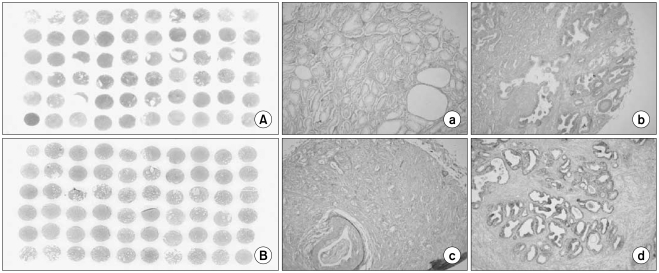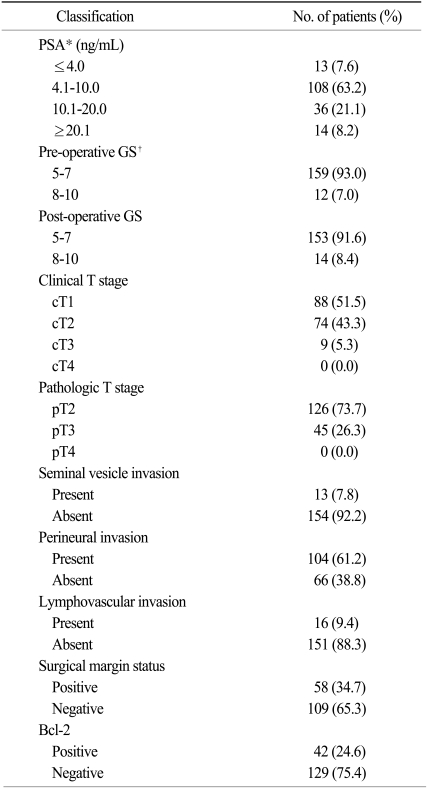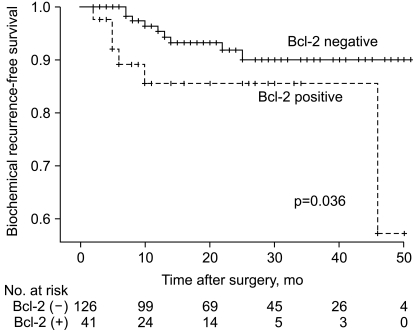1. Kattan MW, Eastham JA, Stapleton AM, Wheeler TM, Scardino PT. A preoperative nomogram for disease recurrence following radical prostatectomy for prostate cancer. J Natl Cancer Inst. 1998; 90:766–771. PMID:
9605647.

2. Kattan MW, Wheeler TM, Scardino PT. Postoperative nomogram for disease recurrence after radical prostatectomy for prostate cancer. J Clin Oncol. 1999; 17:1499–1507. PMID:
10334537.

3. Epstein JI, Partin AW, Sauvageot J, Walsh PC. Prediction of progression following radical prostatectomy: a multivariate analysis of 721 men with long-term follow-up. Am J Surg Pathol. 1996; 20:286–292. PMID:
8772781.
4. D'Amico AV, Chen MH, Roehl KA, Catalona WJ. Identifying patients at risk for significant versus clinically insignificant postoperative prostate-specific antigen failure. J Clin Oncol. 2005; 23:4975–4979. PMID:
16051949.
5. Ross JS, Sheehan CE, Dolen EM, Kallakury BV. Morphologic and molecular prognostic markers in prostate cancer. Adv Anat Pathol. 2002; 9:115–128. PMID:
11917165.

6. Korsmeyer SJ. Bcl-2: an antidote to programmed cell death. Cancer Surv. 1992; 15:105–118. PMID:
1451107.
7. Colombel M, Symmans F, Gil S, O'Toole KM, Chopin D, Benson M, et al. Detection of the apoptosis-suppressing oncoprotein bc1-2 in hormone-refractory human prostate cancers. Am J Pathol. 1993; 143:390–400. PMID:
7688182.
8. Villuendas R, Piris MA, Orradre JL, Mollejo M, Rodriguez R, Morente M. Different bcl-2 protein expression in high-grade B-cell lymphomas derived from lymph node or mucosa-associated lymphoid tissue. Am J Pathol. 1991; 139:989–993. PMID:
1951637.
9. Hur DS, Lee SW, Kim KH, Cho YS, Joo KJ, Park HJ, et al. Significance of expressions of bcl-2 and p53 protein as the prognostic factor in metastatic prostate adenocarcinoma. Korean J Urol. 2001; 42:1265–1269.
10. Berges RR, Furuya Y, Remington L, English HF, Jacks T, Isaacs JT. Cell proliferation, DNA repair, and p53 function are not required for programmed death of prostatic glandular cells induced by androgen ablation. Proc Natl Acad Sci U S A. 1993; 90:8910–8914. PMID:
8415631.

11. Bauer JJ, Sesterhenn IA, Mostofi FK, McLeod DG, Srivastava S, Moul JW. Elevated levels of apoptosis regulator proteins p53 and bcl-2 are independent prognostic biomarkers in surgically treated clinically localized prostate cancer. J Urol. 1996; 156:1511–1516. PMID:
8808919.

12. de la Taille A, Buttyan R, Benson MC, Katz AE. The role of tumor biomarkers as predictors of serum PSA recurrence after radical prostatectomy. Semin Urol Oncol. 1998; 16:137–144. PMID:
9741418.
13. McDonnell TJ, Troncoso P, Brisbay SM, Logothetis C, Chung LW, Hsieh JT, et al. Expression of the protooncogene bcl-2 in the prostate and its association with emergence of androgen-independent prostate cancer. Cancer Res. 1992; 52:6940–6944. PMID:
1458483.
14. Westin P, Stattin P, Damber JE, Bergh A. Castration therapy rapidly induces apoptosis in a minority and decreases cell proliferation in a majority of human prostatic tumors. Am J Pathol. 1995; 146:1368–1375. PMID:
7778676.
15. Raffo AJ, Perlman H, Chen MW, Day ML, Streitman JS, Buttyan R. Overexpression of bcl-2 protects prostate cancer cells from apoptosis in vitro and confers resistance to androgen depletion in vivo. Cancer Res. 1995; 55:4438–4445. PMID:
7671257.
16. Wu TT, Hsu YS, Wang JS, Lee YH, Huang JK. The role of p53, bcl-2 and E-cadherin expression in predicting biochemical relapse for organ confined prostate cancer in Taiwan. J Urol. 2003; 170:78–81. PMID:
12796649.

17. Stackhouse GB, Sesterhenn IA, Bauer JJ, Mostofi FK, Connelly RR, Srivastava SK, et al. p53 and bcl-2 immunohistochemistry in pretreatment prostate needle biopsies to predict recurrence of prostate cancer after radical prostatectomy. J Urol. 1999; 162:2040–2045. PMID:
10569564.

18. Merseburger AS, Kuczyk MA, Serth J, Bokemeyer C, Young DY, Sun L, et al. Limitations of tissue microarrays in the evaluation of focal alterations of bcl-2and p53 in whole mount derived prostate tissues. Oncol Rep. 2003; 10:223–228. PMID:
12469173.
19. Amirghofran Z, Monabati A, Gholijani N. Apoptosis in prostate cancer: bax correlation with stage. Int J Urol. 2005; 12:340–345. PMID:
15948719.

20. Moul JW. Angiogenesis, p53, bcl-2 and Ki-67 in the progression of prostate cancer after radical prostatectomy. Eur Urol. 1999; 35:399–407. PMID:
10325496.
21. Bubendorf L, Tapia C, Gasser TC, Casella R, Grunder B, Moch H, et al. Ki67 labeling index in core needle biopsies independently predicts tumor-specific survival in prostate cancer. Hum Pathol. 1998; 29:949–954. PMID:
9744310.

22. Oxley JD, Winkler MH, Parry K, Brewster S, Abbott C, Gillatt DA. p53 and bcl-2 immunohistochemistry in preoperative biopsies as predictors of biochemical recurrence after radical prostatectomy. BJU Int. 2002; 89:27–32. PMID:
11849156.

23. Marks LS, Kojima M, Demarzo A, Heber D, Bostwick DG, Qian J, et al. Prostate cancer in native Japanese and Japanese-American men: effects of dietary differences on prostatic tissue. Urology. 2004; 64:765–771. PMID:
15491717.

24. Ramos CG, Roehl KA, Antenor JA, Humphrey PA, Catalona WJ. Percent carcinoma in prostatectomy specimen is associated with risk of recurrence after radical prostatectomy in patients with pathologically organ confined prostate cancer. J Urol. 2004; 172:137–140. PMID:
15201754.






 PDF
PDF Citation
Citation Print
Print





 XML Download
XML Download